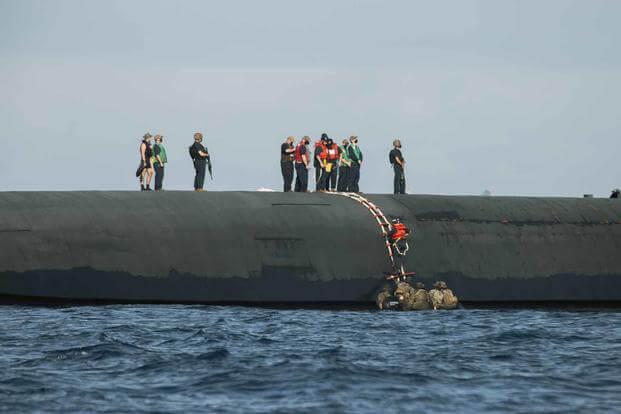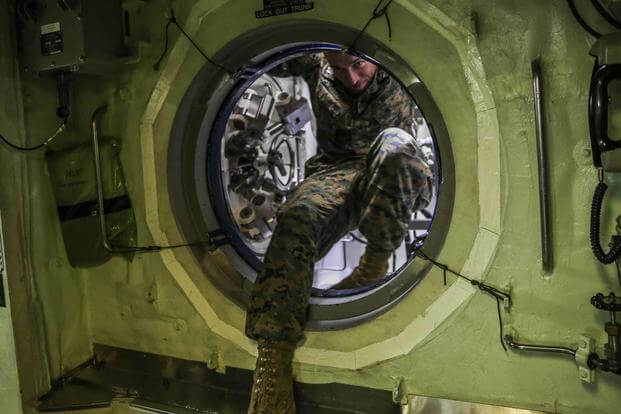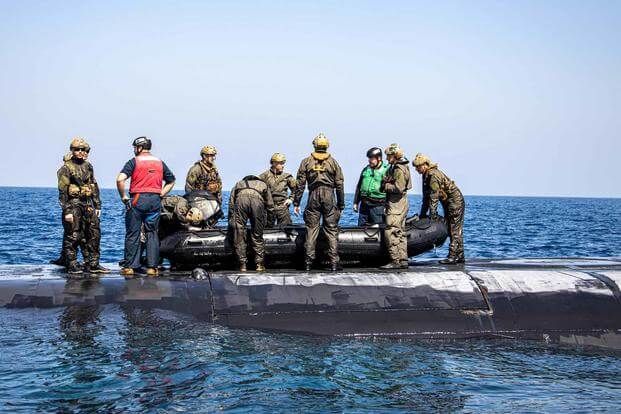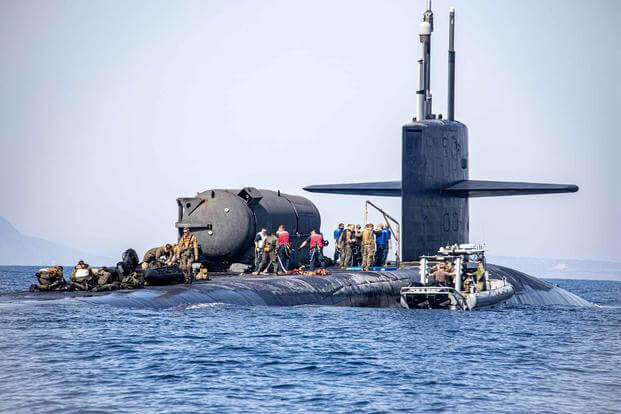Read the original article on Business Insider.
Recent drills involving U.S. Navy submarines and Marine Corps special operators in the Pacific and the Mediterranean highlight an overlooked insertion and exfiltration method that would be relevant in a conflict with China.
In early 2021, Force Recon Marines conducted a rare training with USS Ohio near Okinawa, and earlier this year U.S. Marines trained with USS Georgia in the Mediterranean "to synchronize" Navy and Marine Corps operations.
Although submarine operations are mostly associated with Navy SEALs or U.S. Army Green Beret combat divers, Marine special operators have a long history of submarine operations — Marine Raiders were the first U.S. military unit to conduct a submarine-borne raid, attacking Makin Island in the Pacific in August 1942.
Submarine operations

The main benefit of using submarines for exfiltration and infiltration of special-operations forces is the difficulty of detecting them.
Getting to the fight on a submarine is considerably more discreet than arriving on an MH-60 Black Hawk helicopter or jumping from an MC-130 Combat Talon airplane. If the infiltration and exfiltration are performed properly, the adversary may never know that US commandos and the sub carrying them were there.
Submarine operations allow "Recon Marines and Raiders to infiltrate undetected and conduct reconnaissance or raid missions with low probability of compromise," retired Marine Raider Maj. Fred Galvin told Insider.

This allows those operators to carry out missions of a "strategic nature" but it also "affects the enemy's psychology in that they cannot easily defend against it and in order to defend against it they must commit massive personnel and material resources," added Galvin, who began his career in the Marine Reconnaissance community.
In the vastness of the Pacific, submarine operations could be very important in a conflict with China, allowing Marine special operators to conduct offensive and defensive operations.
"As the stand-in force in the first island chain, it is critical that Force Reconnaissance Marines are capable of being employed across a myriad of US Navy platforms in order to enhance the lethality of the fleet in the littoral environment," Maj. Daniel Romans, commander of the Force Recon company that trained with USS Ohio, said in a press release.
How it's done and why it's risky
However, as with most special-operations infiltration and exfiltration methods, submarine operations come with a lot of risk. Combat diving generally has significant physical risk, which only increases when a nuclear-powered submarine is involved.
"The risks include significant physiological risks while conducting submarine lock in, lock out and closed-circuit diving operation due to complicated pressure changes in the operation," said Galvin, who is author of "A Few Bad Men," an account of the first Marine special operations combat deployment to Afghanistan and how it overcame attacks from all sides.
The lock-in and lock-out technique is used to get operators into and out of a submerged submarine undetected by enemy eyes or sensors. The Navy has a certain number of submarines with specially designed "lock-out trunks."

At the release point, the operators enter the lock-out trunk wearing their scuba gear and the truck is flooded to match the outside water pressure. Once the appropriate pressure is reached, the operators open the trunk's hatch and head to their target, taking with them any necessary gear, such as inflatable boats.
Throughout this procedure, the submarine remains submerged but close to the surface.
During lock-out operations, commandos have to be very careful with their air levels and ensure that the air in the trunk doesn't have too much carbon dioxide, which can be deadly for the operators and compromise the mission, as too much of the gas can create bubbles that an adversary can pick up with sonar.
Lock-outs are no piece of cake, and lots can go wrong during the process, especially when there are operational restrictions — for example, operating at night and the general need for secrecy.

Mistakes under those conditions "can result in convulsions, hypoxia, decompression sickness, as well as becoming disoriented, navigational errors, exhaustion, oxygen toxicity, severe cramps (especially during cold-weather diving operations) and equipment malfunctions, which can lead to not being able to have the entire team continue the subsurface mission," Galvin said.
Some of those side effects can appear after the subsurface phase of the infiltration or exfiltration and can even lead to long-term effects for the operators affected.
Submarine-borne infiltration and exfiltration "has one of the highest operational-risk assessments of all special-operations missions and requires highly trained, specialized diving medical technicians, diving medical officers to operate decompression chambers, and training on submarine chamber operations," Galvin added.
Stavros Atlamazoglou is a defense journalist specializing in special operations, a Hellenic Army veteran (national service with the 575th Marine Battalion and Army HQ), and a Johns Hopkins University graduate.












